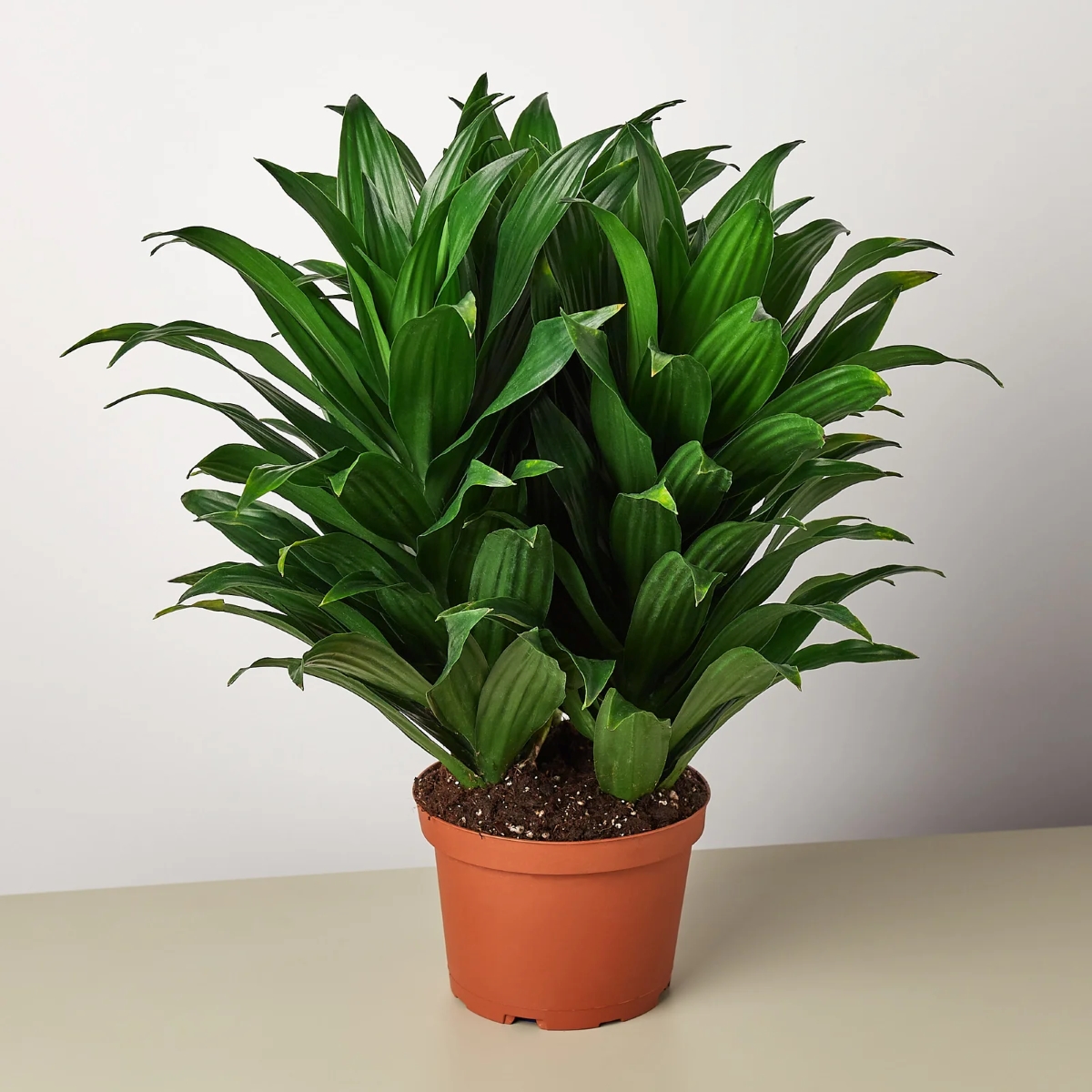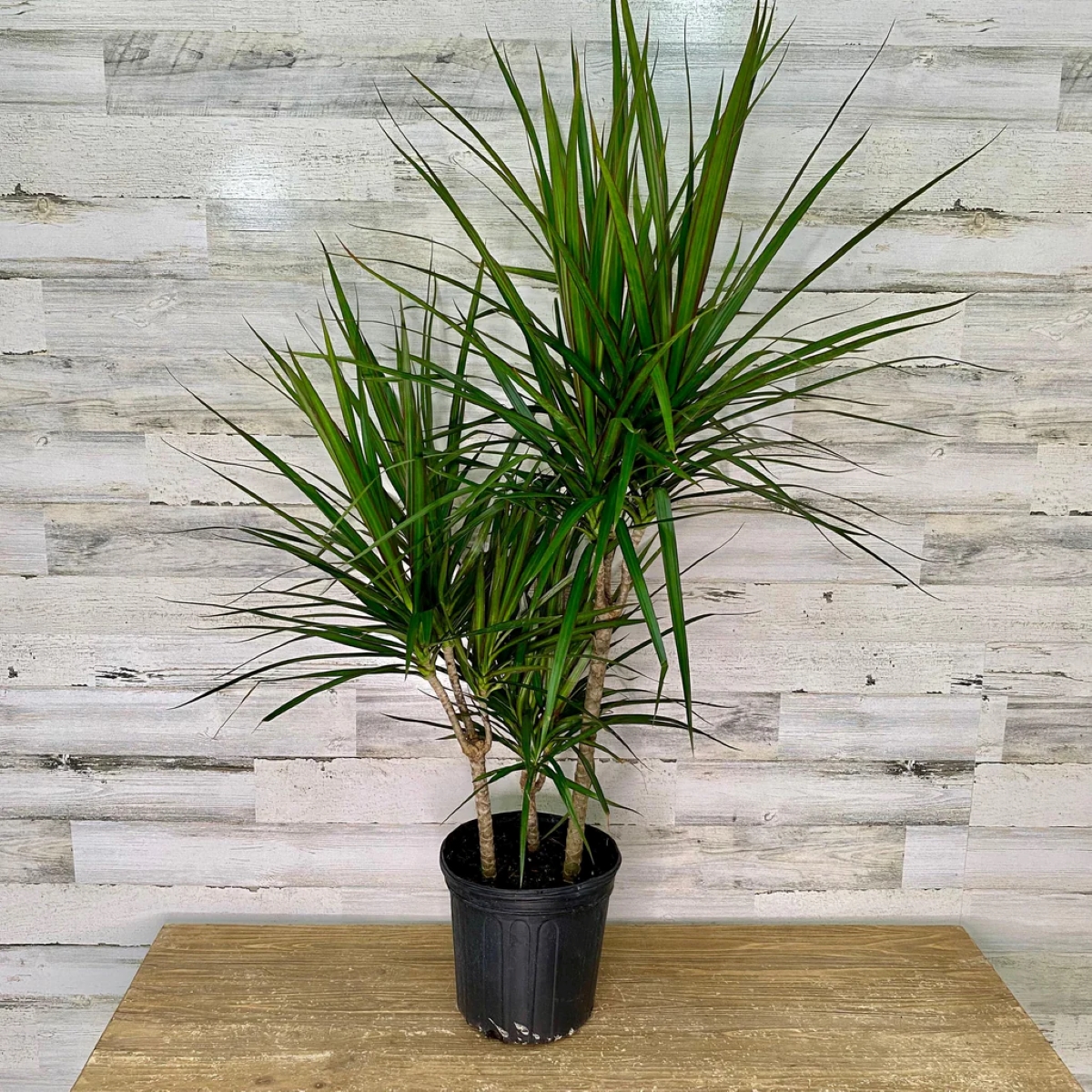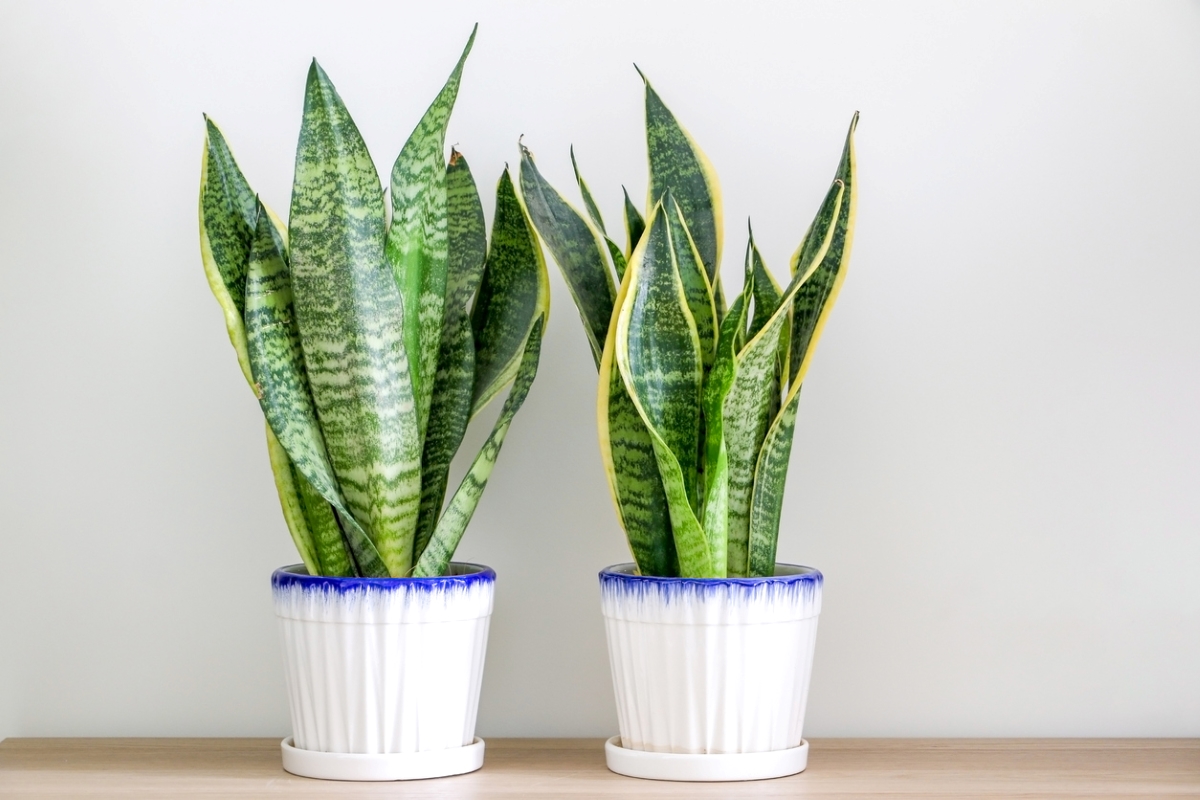We may earn revenue from the products available on this page and participate in affiliate programs. Learn More ›
Dracaena encompasses a variety of tropical plants from Asia, Africa, and Australia that are favored around the world as houseplants because of their ability to thrive in low-light conditions and tolerate drought and low humidity.
Although diverse in appearance, all 120 dracaena varieties grow long leaves from a central cane, an excellent shape for adding height in an interior design. Known for their upright form and straplike leaves that are either green or variegated, dracaenas—sometimes called dragon trees or ribbon plants—make a statement.
It’s important to note that dracaenas contain saponins, which are toxic to cats and dogs.
1. Janet Craig (Dracaena deremensis ‘Janet Craig’)

The Janet Craig dracaena is a tall, bushy plant with long, glossy, green tapering leaves on straight woody stems. Because of its tolerance for shade or bright light, it adapts well as a houseplant. This slow-growing African cultivar typically can reach up to 10 feet tall and, under optimal conditions, can produce clusters of fragrant white flowers.
2. Janet Craig Compact (Dracaena deremensis ‘Janet Craig’ Compacta)

The Janet Craig Compacta is a slow-growing version of its namesake. Though smaller, it still can reach nearly 6 feet high over time. It also produces dark green, glossy, lance-shaped leaves, which grow in a rosette pattern around the cane, lending itself to the nickname “Pineapple Dracaena.” This easy-care dwarf dracaena also tolerates low light and drought. It should be watered only when the soil is dry.
3. Cornstalk Dracaena (Dracaena fragrans ‘Massangeana’)

This dracaena is known by many names, including mass cane plant and corn plant. Whatever you call it, this popular dracaena commonly features large, woody canes sprouting big crowns of lance-shaped, arching leaves with yellow stripes that give it an appearance reminiscent of a cornstalk. Indoors, this dracaena tree can easily reach 6 feet tall. In its native habitat, the corn plant flower blooms at night with a strong, sweet scent, but the cornstalk dracaena rarely blooms when grown indoors.
RELATED: 20 Low-Light Houseplants You Can Grow Practically Anywhere
4. Limelight Dracaena (Dracaena deremensis ‘Limelight’)

Bright chartreuse, sword-shaped leaves are the reason for Limelight’s name. The yellow-green leaves mature into a bold lime color. A bushy plant that can reach 4 feet to 7 feet tall and almost as wide, Limelight is an ideal dracaena for indoors because low or indirect light can help it retain its distinctive coloring. When paired with plants of darker green, red, or purple foliage, it really pops.
5. Red-Edged Dracaena (Dracaena marginata)

Dracaena identification is easy with the dragon tree; its red-margined leaves give it away. Known as the Madagascar dragon tree for obvious reasons, its thin, tapered leaves grow on skinny canes trained to twist and bend to create eye-catching shapes. The longer leaves arch downward in a fountain effect. This dracaena often is sold with multiple trunks to provide a full head of spiky leaves. Although they prefer bright, indirect light, this dracaena can survive on low light and little water.
6. Tricolor Dracaena (Dracaena marginata ‘Tricolor’)

The tricolor dracaena—or rainbow plant—is merely a lighter version of the Madagascar dragon tree. It features the same thin, straplike leaves, but the leaves have a center band of green that is surrounded by a narrow band of gold and edged with a stripe of red. This dracaena shares the same shape, size, and care requirements as the more familiar dragon tree. Dragon trees typically grow to 6 to 8 feet indoors.
7. Snake Plant (Dracaena trifasciata)

The snake plant—or mother-in-law’s tongue—is actually a succulent dracaena that shoots up tall, stiff, straight, broad golden-edged leaves from the soil. The blade-like leaves can grow to nearly 8 feet high. Known as a superior air filter for interior spaces, the snake plant is loved for its easy-going nature. It prefers bright, indirect light, but it can tolerate low light. Snake plants also tolerate a wide range of temperatures and don’t need a lot of watering.
RELATED: The One Rule of (Green) Thumb When Decorating With Houseplants
8. Lucky Bamboo (Dracaena sanderiana)

With its ribbed green canes topped by bright-green straplike leaves, this dracaena resembles bamboo in appearance. However, the West African herbaceous perennial is not related to the Asian grass. Often trained into curled and twisted forms, this popular novelty plant thought to bring good luck can be grown in moist soil or hydroponically. It can tolerate shade or indirect light, as long as it’s out of direct sun.
9. Ribbon Plant (Dracaena sanderiana ‘Variegata’)

Ribbon plant is the same species as lucky bamboo, distinguishable from the latter by the presence of creamy-white margins on its leaves. Like its cousin, it can be grown hydroponically or in soil. Because it’s shorter than most dracaenas, it’s often used in terrariums, and because it can tolerate short periods of submersion, it is also used in aquariums.
10. Warneckei Dracaena (Dracaena deremensis ‘Warneckei’)

A tall, resilient dracaena that can reach 4 to 5 feet tall indoors, Warneckei is a slow grower recognizable by the creamy-white stripes on its long, sword-shaped green leaves atop sturdy canes. It’s so easy to care for, it even survives neglect—all the while working for you. NASA cited Warneckei, dragon tree, and cornstalk dracaena as among the best at removing toxins such as xylene, formaldehyde, and toluene from the air.
11. Lemon Lime Dracaena (Dracaena deremensis ‘Lemon Lime’)

Making dracaena identification easy, Lemon Lime dracaena, which is similar to Warneckei, has yellow and chartreuse stripes around a central band of sword-shaped, lighter green foliage. This low-maintenance houseplant can reach 5 to 6 feet in height and requires minimal care. It can tolerate partial sun, and it likes moist soil.
12. Song of India Dracaena (Dracaena reflexa ‘Song of India’)

Song of India dracaena (formerly known as Pleomele reflexa), features yellow-gold and green sword-shaped leaves that grow in groups of three or four on straight, upright canes. The plant is often sold with multiple stems in a pot for a fuller effect, although it’s already a bushy plant. The flower shoots are reflexed, bending in the center. In optimal conditions (though rarely), aromatic white flower clusters will bloom, followed by orange-red berries.
RELATED: 23 Philodendron Varieties Perfect for Filling Out Your Houseplant Collection
13. Florida Beauty Gold Dust Dracaena (Dracaena surculosa ‘Florida Beauty’)

Smaller and bushier than many other dracaenas, Florida Beauty usually tops out around 2 feet high. Instead of the typical sword-shaped leaves, this slow grower produces rounded, almost oval, leaves that have a point at the tips. Known as gold dust dracaena because its leaves are spotted with splashes of a creamy yellow, this plant is a multistemmed dracaena.
14. White Jewel Dracaena (Dracaena deremensis ‘White Jewel’)

Dark green, glossy leaves are bordered with white, creating a dramatic show of color on the sword-shaped leaves. For the best color, White Jewel should be placed in bright, indirect light. Given proper light, moderate temperatures, 40 percent to 60 percent humidity, and enough water to keep the soil moist, White Jewel is an easy plant to keep. It will enjoy summering outside in filtered sunlight.
15. Tornado Twist Dracaena (Dracaena fragrans ‘Tornado Twist’)

This slow-growing dracaena dazzles with its twists and curls. Dark green leaves are edged in lime. It tolerates a wide range of conditions and is so easy to grow, it’s labeled “almost unkillable.” Young plants feature a low, rounded shape. It grows along an upright central stem, eventually reaching about 4 to 6 feet tall, with a spread of about 3 feet.
16. Lemon Surprise Dracaena (Dracaena deremensis ‘Lemon Surprise’)

Like the Tornado Twist, Lemon Surprise features whorls of leaves—this time, in lemon yellow and lime green. A bushy plant, it can grow 2 to 3 feet tall and almost as wide. For the best color, this dracaena prefers bright, indirect light; moderate watering and temperature; and 40 to 60 percent humidity.
RELATED: 11 Indoor Gardening Projects Absolutely Anyone Can Do
17. Milky Way Dracaena (Dracaena surculosa ‘Milky Way’)

Spots and stripes dominate Milky Way’s coloring. Broad, elliptical leaves feature wide bands of white down the center, with white speckles on the green edges. They grow on thin, arching stems. Bright filtered light and sufficient space for its roots will help maintain its out-of-this-world coloring. It also prefers high humidity and moderate watering. This stunner is rare and not easy to find.
18. Gold Dracaena (Dracaena sanderiana ‘Gold’)

Slightly twisted, dark green, straplike leaves are highlighted by wide lemon-lime edges on this low-maintenance, drought-tolerant plant. Bold, bright color on this small, shrubby tropical dracaena belies its ease of care. Like other dracaenas, it can tolerate low levels of light, moderate indoor temperatures, and moderate watering, but it prefers high humidity.
19. Kiwi Dracaena (Dracaena marginata ‘Kiwi’)

This dragon tree features long, thin, spiky leaves with an ivory center and dark green edges. Growing to 3 feet to 6 feet tall, it’s recognizable as a marginata. Like other marginatas, Kiwi prefers bright, indirect light, along with moderate watering and temperatures, but because it has less green in its leaves, it wants more sunlight than other dracaena varieties to maintain the vibrant variegation.
20. Zebra Striped Dragon Tree (Dracaena goldieana)

The Zebra Striped Dragon Tree, or Green Zebra Plant, displays stripes that run across its ovate leaves, rather than along them. Light green variegation on deep green leaves produces a marbling effect, somewhat mimicking the stripes of a zebra. New foliage emerges from the center stalk and features a red underside. Capable of growing 4 feet to 10 feet tall, this popular specimen tolerates medium light, medium watering, and medium humidity.
RELATED: 14 Plant Shelf Ideas to Liven Up Any Blank Space in Your Home


